
For a long time, people used to use Geekbench, Cinebench, PCMark 3DMark Wait, test Software , to measure the performance of core hardware such as PC processors. For a while, the running score became the only standard to judge the hardware performance. This trend has not only deeply affected the PC circle, but also affected the smartphone industry. One of the most classic is the sentence "running for a minute if not convinced".

·Why use scoring software for evaluation?
In fact, from the perspective of media, it is a traditional and convenient way to use test software to measure hardware performance. Because testing once generates a certain score, product reviewers can describe the differences between different hardware and configurations in a more concrete and comparative way.
But in fact, most of the time, these test results are only a reference, and cannot be used as the only standard to judge a certain hardware. The most important reason is that there is a big difference between the score of test software and the actual application, and the test items of different test software are different, which can not fully reflect the true performance of hardware in the actual application.
·Can the score of scoring software measure the overall performance of hardware?
Take the well-known Geekbench software commonly used in processor evaluation as an example. It is one of the CINEMA 4D rendering software developed by Maxon Computer in Germany Benchmark Programs like V-Ray Blender Benchmark program of renderers such as, OCtane, etc.
Cinebench is mainly used to judge the single core, multi-core and OpenCL rendering efficiency of processors in the CINEMA 4D environment. It is mainly an auxiliary reference tool for CINEMA 4D developers, so it has obvious limitations. For example, if you are watching this article, do you usually use CINEMA 4D?
We all know that a piece of software will have corresponding optimization for different hardware, and the compiler used is different, and the instruction set called is different accelerator Different factors will affect the final rendering efficiency. Of course, this is understandable, because we can't ask software companies to adapt every piece of hardware, which will cost unimaginable costs. Therefore, Benchmark programs like Cinebench are only suitable for judging the performance of processors in CINEMA 4D rendering, and cannot represent the performance of processors in CINEMA 4D rendering CAD , Maya, etc. We can't judge hardware in games Office Performance in office and other practical applications.
·How different is the software score from the actual application?
Some friends may ask why they are using software like Cinebench to judge the performance of processors?
In fact, there is nothing difficult to understand. First, Cinebench is a freeware , and the test time is short and easy to operate. Professional media can save time and effort, and digital KOL has no threshold to use; Moreover, the industry has formed a habit of using Cinebench R10, R11.5, R15 to R20. However, these two reasons have nothing to do with whether Cinebench can comprehensively measure processor performance. So sometimes, if you look carefully at the evaluation, you will find that the test results are only for reference, not the only standard for judging performance. However, I believe that most people naturally ignore this sentence when they see it.
So what's the difference between running scores and actual application? Let's give a simple example.
Recently, we used the Intel 10 generation Core i7-10750H platform and AMD Ryzen 7 4800H platform for game testing. The specific configurations are as follows:

Let's take a look at the following screenshots of the game test:
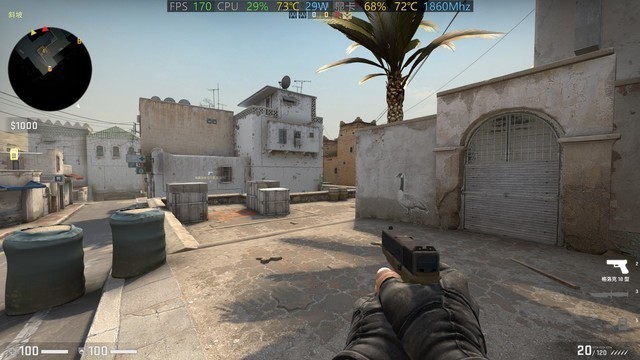 Desert II map, sampling scene frames: 170 (Intel 10 Core)
Desert II map, sampling scene frames: 170 (Intel 10 Core)
 Desert II map, sampling scene frames: 149 (AMD third-generation sharp dragon)
Desert II map, sampling scene frames: 149 (AMD third-generation sharp dragon)
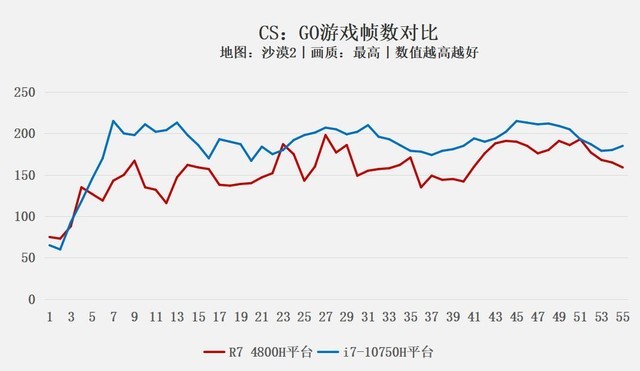
As we all know, the Intel 10 generation Core i7-10750H is a 6-core 12 thread processor, while the AMD Ryzen 7 4800H is an 8-core 16 thread processor. If you look at the number of cores and use the rendering class Benchmark for testing, such as Cinebench, V-Ray, Blender, etc., you will find that the i7-10750H scores lower than the latter. This is because such applications themselves depend on the number of cores and threads. If you want to make this comparison, it should not be the i7-10750H, but the i7-10875H with 8 cores and 16 threads.
You should know that the performance of processors is not limited to multi-core multithreading. Mainstream applications such as games actually rely more on the acceleration ability of the main frequency and Rui Frequency. So we can see the results in the above two pictures. Intel's 10th generation Core i7-10750H platform《 CS GO During the game, the frame number will be significantly ahead of the AMD Ryzen 7 4800H platform. At this time, if you only refer to the test results of rendering benchmark programs such as Cinebench, V-Ray, etc., how can you expect the performance in the actual game?
Another example《 League of Heroes 》The test results of this game are as follows:
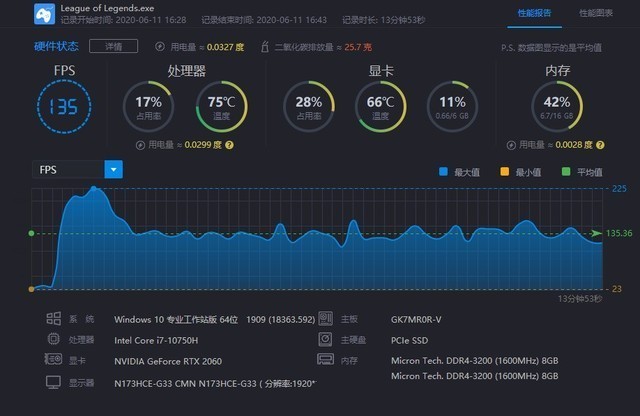
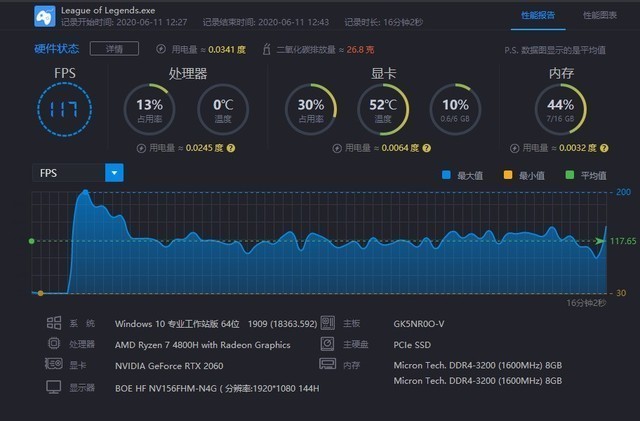
It can be seen that the average frame number of Intel 10 generation Core i7-10750H platform can reach 135fps, while the average frame number of AMD Ryzen 7 4800H platform is only 117fps. Such results can also not be learned from such scoring software as Cinebench, V-Ray, Geekbench.
In addition, the same is true in high quality 3A masterpieces, such as《 Assassin's Creed Odyssey is a game that requires high hardware performance. The Intel 10 generation Core i7-10750H platform is superior to the AMD Ryzen 7 4800H platform in terms of the highest and average frame performance.
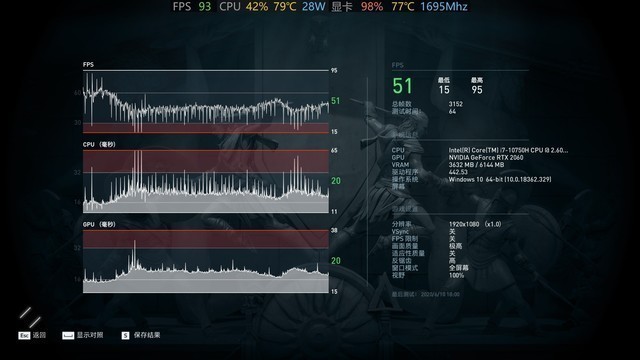 Intel 10 generation Core, the highest average image quality: 51fps, the highest: 95fps, the lowest: 15fps
Intel 10 generation Core, the highest average image quality: 51fps, the highest: 95fps, the lowest: 15fps
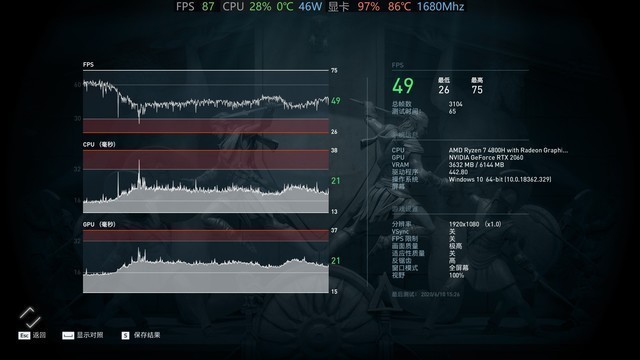 AMD's third-generation Sharp Dragon, the highest average image quality: 49fps, the highest: 75fps, the lowest: 26fps
AMD's third-generation Sharp Dragon, the highest average image quality: 49fps, the highest: 75fps, the lowest: 26fps
In addition, some games that require multi-core and high frequency at the same time, such as the most typical《 Mount & Blade 2: The same is true of Intel's 10th generation Core i7-10750H platform. In the same scenario, the 10th generation Core platform is about 20 fps higher than AMD's 7 4800H platform on average.
 Intel 10 generation Core platform test, sampling scene frames: 114fps
Intel 10 generation Core platform test, sampling scene frames: 114fps
 AMD third-generation Reelung platform test, sampling scene frames: 95fps
AMD third-generation Reelung platform test, sampling scene frames: 95fps
Finally, we can see the summary of the comparison of game test results, as follows:
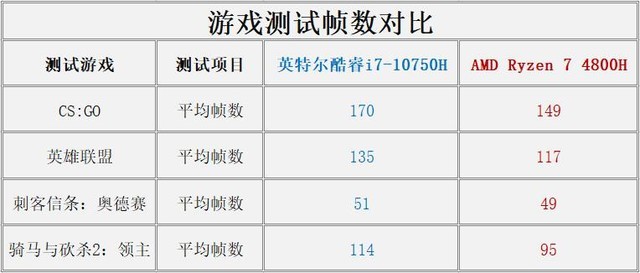
In fact, we have tested more different games before. Intel's 10th generation Core i7-10750H platform benefits from better Remax capability, and the number of frames of most games is significantly higher than that of AMD Ryzen 7 4800H platform. Please refer to《 Ten generation Core VS three generation Reelong: who is more suitable for playing games? 》
In addition, Intel has also conducted performance tests of the 10th generation Core in mainstream games on the following platforms: Lenovo Saver Y7000 And R7000, the specific configuration is as follows:
Processor: Intel 10 generation Core i7-10750H/AMD Ryzen 7 4800H
Memory: 16GB
Hard disk: 512GB SSD
Graphics card: NVIDIA GeForce GTX 1650Ti
Combined with Intel's test results (14 of the 36 test games lead by more than 10%, the average number of frames of 21 games lead by 3%~10%, and only one game has the same frame performance), and our horizontal evaluation test data, it can be seen that scoring software is actually a reference factor in product evaluation, It does not fully reflect the performance of a piece of hardware in various practical applications.
·How do ordinary users judge hardware performance?
Media and KOL can often obtain test products provided by manufacturers, so it is conditional to compare the performance of multiple configured models at the same time. And the way is not limited to running score software, but also can do practical application experience, such as Office Photoshop Drawing, games, etc. But for ordinary consumers, it is difficult to have the opportunity to compare the experience of machines with different configurations in actual applications at the same time. Therefore, we can only judge the strength of hardware performance through intuitive and understandable scoring, which makes it impossible to distinguish the difference between PC hardware in scoring and actual applications.
How should ordinary users judge hardware performance?
For processors, there are two main concerns. One is the number of cores, and the other is the main frequency and Rui frequency capabilities. The former is mainly responsible for various multithreaded tasks, while the latter mainly determines the efficiency of completing tasks. The former mainly plays a leading role in daily office applications, while the latter mainly plays a strong role in games and other applications that do not rely on multiple cores.
Therefore, processors with multi-core and high dominant frequency/high Rui frequency capabilities may not have an advantage in software scoring, but most of them are not bad in practical applications, because such processors have no weaknesses. This is the main reason why the Intel 10 generation Core i7-10750H with 6 cores and 12 threads can defeat the AMD Ryzen 7 4800H with 8 cores and 16 threads in the game.
This article is an original article. If it is reproduced, please indicate the source: How big is the difference between i7-10750H PK R7-4800H score and actual application? //nb.zol.com.cn/751/7510236.html
//nb.zol.com.cn/751/7510236.html
nb.zol.com.cn
true
Zhongguancun Online
//nb.zol.com.cn/751/7510236.html
report
six thousand and ninety
For a long time, people used to use Geekbench, Cinebench, PCMark, 3DMark and other test software to measure the performance of core hardware such as PC processors. For a while, the running score became the only standard to judge the hardware performance. This trend has not only deeply affected the PC circle, but also affected the smartphone industry. Among them, the most classic one is the sentence "running for a minute..."





























